
You wonder why reading sanskrit is so important. That problem has now been resolved so we may well get a flood of old Indian docs.
If it includes plenty of math and science, we will be happy.
There is plenty there hidden behind the wall of our indifference and ignorance. I do want to see if we can get back before the last three thousand years. Way too many docs to be just a short blip in time.
Vimana: The Ancient Indian Aerospace Craft – Time for Indigenisation
https://www.blogger.com/blog/post/edit/1752027331714385066/7609275202433192932
https://rumble.com/v1zh63j-the-lost-secret-key-of-red-mercury-ancient-aryan-vimanas-secret.html
Atmanirbharta (indigenisation), or achieving self-reliance in defence manufacturing is one of the key national objectives of India today. The focus has been on reducing dependency on defence imports and indigenisation of the items presently being imported. A key area of action is the aerospace, which is not only cost intensive but also sees early obsolescence. The Germans, the Chinese and many others have been avid fans of India’s ancient past and the vast knowledge that is so well documented in the ancient manuscripts. Lot more information may be residing in millions of still unread documents held in thousands places of different Indian religions and sects. Some of them may be a gold mine of information that may propel India back to the position of glory it once held. Vimana is just one such stories.

10 Mathematical inventions in India that changed the world. Image Source: You Tube
Early Mathematical concepts
India is known to have given to the world most major concepts of mathematics, some as far back as 1200 BC. Aryabhata, Brahmagupta, and Bhaskara were famous mathematicians of the period 400 to 1200 AD. The concept of zero, the decimal system, negative numbers, arithmetic and algebra were Indian contributions. Trigonometric functions sine and cosine were added by ancient Indians. Even practical mathematics covering measures of length, proportions, ratios, weights, geometric shapes were also evolved. Large numbers from 100 to a trillion were in use in Vedic period. For construction those days Pythagorean Theorem and geometric area equivalence were used. India is estimated to have about thirty million manuscripts dating back to 700 BC. The knowledge of Mathematics was germane to scientific research.

‘Shakuna Vimana’ described in the text ‘might be defined as a cross between a modern plane and a rocket. Image Source: bharatuntoldstory.wordpress.com
The Ancient References
The Sanskrit word ‘Vimana’ (meaning a part that has been measured and set aside) first appeared in Vedas with several meanings ranging from temple or palace to mythological flying machine. References to these flying machines were common in ancient Indian texts, even describing their use in warfare, and being able to fly within Earth’s atmosphere. Vimanas were also said to be able to travel into space and under water. The Sun and Indra and several other Vedic deities were transported by flying wheeled chariots pulled by animals, usually horses, but others like the “agnihotra-vimana” (Agni means fire) with two engines and the “gaja-vimana” (elephant powered) were known. Rigveda also talks of “mechanical birds”. Later texts around 500 BC talk of self-moving aerial car without animals. In some modern Indian languages, the word vimana means aircraft.
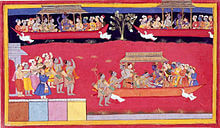
Pushpaka vimana depicted three times, twice flying in the sky and once landed on the ground. Image Source: Wikipedia
As per Ramayana Pushpaka (the flowery Chariot) was originally made by Vishwakarma for Brahma the Hindu god of creation. Brahma gifted it to Kubera, the God of wealth, but was stolen, along with Lanka, by his half-brother, the demon king Ravana. It reportedly resembled the sun, and could go everywhere at will. There are mentions of Lord Rama using it, and under the command of Raghira (Captain), the chariot reportedly rose up into the higher atmosphere. This celestial self-propelled car was large, had two stories and many chambers with windows, and was draped with flags and banners.
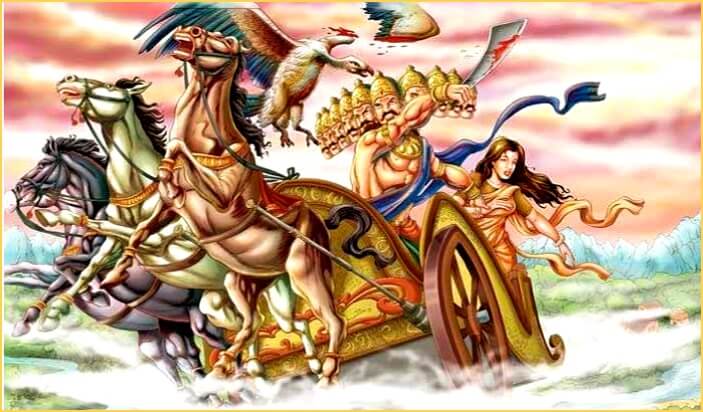
Ravana taking Site in the Flying Chariot and being attacked by the mythical bird Jatayu. Image Source: astrotalk.com
By the time of the Mahabharata (400 BC), these flying chariots had grown in size but they never lost the large wheels. Mahabharata mentions the genius Yavanas as creator (Chief Designer) of a finite dimensioned Vimana with four solid wheels owned by Asura Maya. Jain literature talks of the various Tirthamkaras flying different types of flying machines. Starting from the 4th tirthamkara travelling in Jayanta Vimana, to the very famous 24 th Tirthamkara Mahavira emerging out of a great Vimana Pushpa-uttara.

Krishna and Rukmini as Groom and Bride in a Celestial Chariot Driven by Ganesha. Image Source: Pinterest
Recent Studies
Mr. G. R. Josyer, former Director of the International Academy of Sanskrit Research in Mysore, claimed that the Academy had collected manuscripts that were compiled by ancient Rishis thousands of years ago. One manuscript dealt with Aeronautics, construction of various types of aircraft for civil aviation and for warfare. Designs and drawing of a helicopter-type cargo plane, specially meant for carrying combustibles and ammunition, and a double and treble-decked passenger aircraft carrying 400 to 500 persons were reportedly recorded.
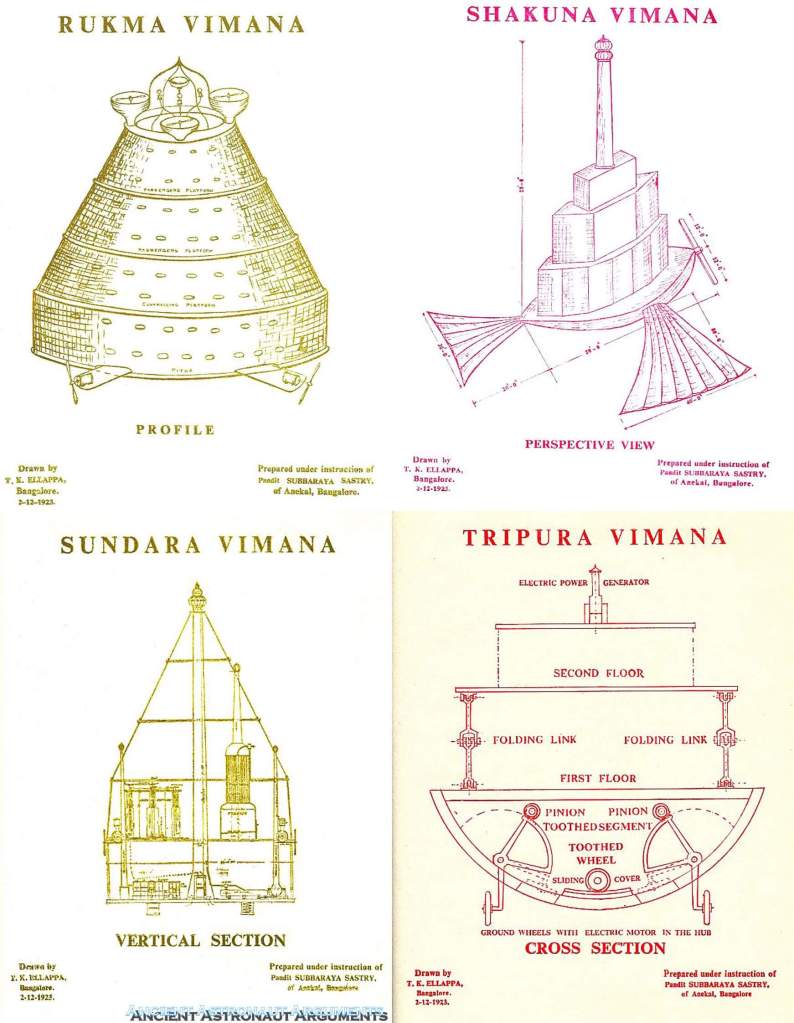
Ancient Indian flying vehicles. Image Source: Pinterest
Vaimanika Shastra translated in early 20th century covers definitions of airplane, pilot, aerial routes, and planes are described in great detail. In 1991, a book by David Hatcher Childress, ‘Vimana Aircraft of Ancient India & Atlantis’ covered the secrets of constructing aero planes that will not break, will not catch fire, and cannot be destroyed. Also secret of making planes motionless (hovering), of making them invisible (stealth), the secret of retrieving photographs of the interior of enemy planes (intelligence), the secret of ascertaining the direction of enemy planes approach (radar), the secret of making persons in enemy planes lose consciousness and the secret of destroying enemy planes.

The propulsion system. Image Source: Pinterest
The propulsion of the Vimanas according to Kanjilal (1985) was by “Mercury Vortex Engines”, apparently a concept similar to electric propulsion. Childress also finds evidence for the mercury vortex engine in the Samarangana Sutradhara, an 11th century treatise on architecture.

Vimana and the Temple Designs. Image Source: Pinterest
Texts say “Vimanas are powered by some jet engines. This seems to be true from the description of the flight behavior. Elephants ran away in panic; grass was thrown out because there was a lot of pressure from behind those Vimanas. The Vimanika Shastra refers to metals used in these crafts. There is mention of electricity and power sources, of pilots and their flying clothing, about the food that they eat. It talks even about the weapons that are kept on these airships.The flight manuals of the Vimanas are quite similar to the flight manuals you find in the modern civil and military aircraft. It suggests that Vimanas were powered by several gyroscopes placed inside a sealed liquid mercury vortex. One of the texts talks about mercury rotating and driving some sort of a powerful propeller or fan.
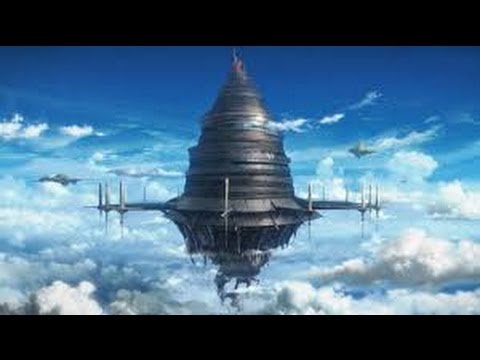
Vimana Shastra and Mercury Vortex Engine. Image Source: You Tube
There are references to flying machines in the temple carvings and in the ancient writings. Most ancient Sanskrit manuscripts have still to be translated into English. It is claimed that a few years ago, the Chinese discovered some Sanskrit documents in Lhasa, Tibet and sent them to be translated. Dr. Ruth Reyna who under took the exercise, said recently that the documents contain directions for building interstellar spaceships. The method of propulsion, she said, was anti-gravitational, a system similar to that of “laghima”, the unknown power of man’s ego, a centrifugal force strong enough to counter gravitational pull. Hindu Yogis, for long have maintained “laghima” enables a person to levitate. Dr. Reyna said that on board these machines, which were called “Astras”, the ancient Indians could have sent a detachment of men onto any planet.

Carvings on Ganesha Ratha in comparison with modern rockets. Image Source: http://www.researchgate.net
Linkages to Modern Avtars
Vimanas were kept in a Vimana Griha, a kind of hanger, and were sometimes said to be propelled by a yellowish-white liquid, which sounds more like gasoline. Perhaps Vimanas had a number of different propulsion sources, including combustion engines and even “pulse-jet” engines. It is interesting to note that when Alexander invaded India in 300 BC, his historians chronicled that at one point they were attacked by “fiery flying shields” that dived at his army and frightened the cavalry.

5000 year old Flying Machine image found by American Soldiers in Afghan Cave. Image Source: Pinterest
The Nazis developed the first recent pulse-jet engines for their V-8 rockets. Hitler and the Nazi staff were greatly interested in ancient India and Tibet and sent regular expeditions to both these places in the 30’s to gather evidence. Interestingly, Soviet scientists discovered old instruments used in navigating cosmic vehicles in caves in Turkestan and the Gobi Desert.
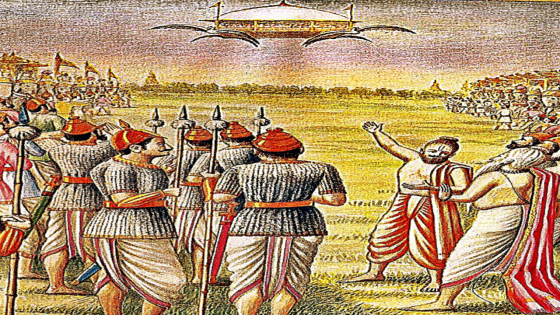
Ancient Indian Vimana. Image Source: aloneworld.in
As per John Burrows, Sanskrit texts have references to gods who fought battles in the sky using Vimanas equipped with weapons as deadly as in current times. Indra’s Dart operated using a circular reflector. When switched on, it produced a ‘shaft of light’ which, when focused on any target, immediately consumed it with its power (Laser Weapons).

Indra the God of Thunder and Lightening. Image Source: Pinterest
There are references of highly maneuverable and powerful Vimanas launching single projectiles charged with ‘all the power of the Universe’ against cities, resulting in huge columns of smoke and fire equivalent to tens of thousands of suns. This Iron Thunderbolt gigantic messenger of death reportedly reduced to ashes the entire race of the Vrishnis and Andhakas. These kinds of records are not isolated and can be cross-correlated with similar reports in other ancient civilizations. Were these nuclear weapons?

Vimana of Chenna Kesava Temple. Image Source: commons.wikimedia.org
Many western researchers studying UFOs tend to overlook possible origin in ancient India. Even many modern day Indians did not take the texts very seriously, but woke up when the Chinese announced that they were studying this data for their space program. From the manuscripts it is not clear if interplanetary travel was ever made but there is a mention of a planned trip to the Moon. However, the Ramayana, does have a highly detailed story of a trip to the moon in a Vimana, including details of a battle on the moon with an ‘Asvin’(Atlantean airship).

The Vimana Parva of Mahabharata. Image Source: thenirvanainstinct.wordpress.com
The Samara Sutradhara is a scientific treatise dealing with every possible angle of air travel in a Vimana (Civil Aviation). There are 230 stanzas dealing with the construction, take-off, cruising for thousands of miles, normal and forced landings, and even possible bird strikes. It dealt with aircraft operations, included information on the navigation, precautions for long flights, protection of airships from storms and lightening and change over to “solar energy” for cruise.
More recently, Vimanas have appeared in books, films, internet and video games. Interstellar propulsion system called ‘Vimana Drive’ is used in the space exploration game Noctis. Producer Etnica released film ‘Vimana’ in 1997 includes references to UFOs and alien life forms. Michael Scott (Irish author) wrote The Secrets of the Immortal Nicholas Flamel, a fantasy series that included flying vimanas.
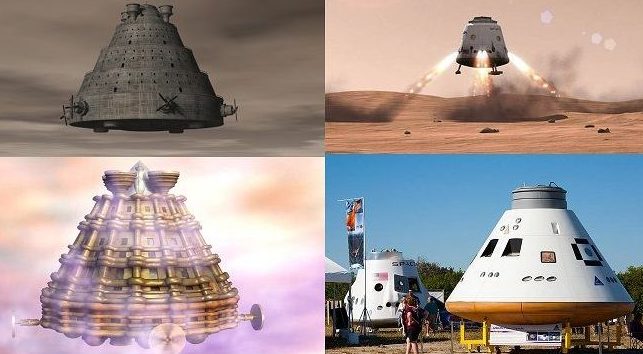
Nasa’s Spacecraft Dragon similarity with Ancient Indian Vimana. Image Source: http://www.themysteriousindia.net
NASA (National Aeronautical and Space Administration) is trying to create an ion engine that uses a stream of high velocity electrified particles. Interestingly the aircraft engines being developed for future use by NASA, by some strange coincidence also use mercury bombardment units powered by Solar cells.The world continues to crave for ancient Indian knowledge. Can India one day regain its lost glory and knowledge as the leader of Science and Technology? As Indian PM Narendra Modi’s pushes indigenization of defence production, India needs to remember that once it was a great aerospace power.
No comments:
Post a Comment